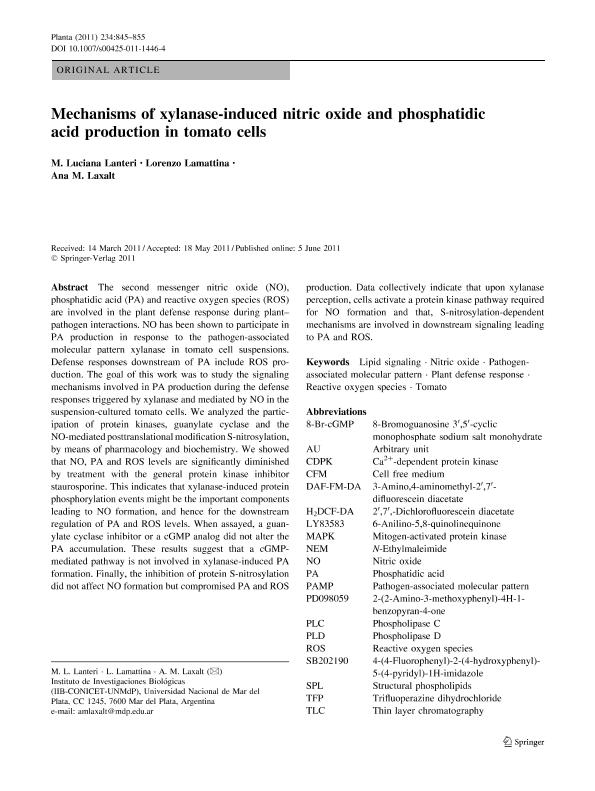Mostrar el registro sencillo del ítem
dc.contributor.author
Lanteri, Maria Luciana

dc.contributor.author
Lamattina, Lorenzo

dc.contributor.author
Laxalt, Ana Maria

dc.date.available
2017-02-15T15:36:48Z
dc.date.issued
2011-10
dc.identifier.citation
Lanteri, Maria Luciana; Lamattina, Lorenzo; Laxalt, Ana Maria; Mechanisms of Xylanase-induced Nitric Oxide and Phosphatidic Acid Production in Tomato Cells; Springer; Planta; 234; 4; 10-2011; 845-855
dc.identifier.issn
0032-0935
dc.identifier.uri
http://hdl.handle.net/11336/13050
dc.description.abstract
The second messenger nitric oxide (NO), phosphatidic acid (PA) and reactive oxygen species (ROS) are involved in the plant defense response during plant–pathogen interactions. NO has been shown to participate in PA production in response to the pathogen-associated molecular pattern xylanase in tomato cell suspensions. Defense responses downstream of PA include ROS production. The goal of this work was to study the signaling mechanisms involved in PA production during the defense responses triggered by xylanase and mediated by NO in the suspension-cultured tomato cells. We analyzed the participation of protein kinases, guanylate cyclase and the NO-mediated posttranslational modification S-nitrosylation, by means of pharmacology and biochemistry. We showed that NO, PA and ROS levels are significantly diminished by treatment with the general protein kinase inhibitor staurosporine. This indicates that xylanase-induced protein phosphorylation events might be the important components leading to NO formation, and hence for the downstream regulation of PA and ROS levels. When assayed, a guanylate cyclase inhibitor or a cGMP analog did not alter the PA accumulation. These results suggest that a cGMP-mediated pathway is not involved in xylanase-induced PA formation. Finally, the inhibition of protein S-nitrosylation did not affect NO formation but compromised PA and ROS production. Data collectively indicate that upon xylanase perception, cells activate a protein kinase pathway required for NO formation and that, S-nitrosylation-dependent mechanisms are involved in downstream signaling leading to PA and ROS.
dc.format
application/pdf
dc.language.iso
eng
dc.publisher
Springer

dc.rights
info:eu-repo/semantics/openAccess
dc.rights.uri
https://creativecommons.org/licenses/by-nc-sa/2.5/ar/
dc.subject
Lipid Signaling
dc.subject
Nitric Oxide
dc.subject
Pathogen-Associated Molecular Pattern
dc.subject
Plant Defense
dc.subject
Response
dc.subject
Reactive Oxygen Species
dc.subject
Tomato
dc.subject.classification
Bioquímica y Biología Molecular

dc.subject.classification
Ciencias Biológicas

dc.subject.classification
CIENCIAS NATURALES Y EXACTAS

dc.title
Mechanisms of Xylanase-induced Nitric Oxide and Phosphatidic Acid Production in Tomato Cells
dc.type
info:eu-repo/semantics/article
dc.type
info:ar-repo/semantics/artículo
dc.type
info:eu-repo/semantics/publishedVersion
dc.date.updated
2017-02-10T18:12:55Z
dc.identifier.eissn
1432-2048
dc.journal.volume
234
dc.journal.number
4
dc.journal.pagination
845-855
dc.journal.pais
Alemania

dc.journal.ciudad
Berlín
dc.description.fil
Fil: Lanteri, Maria Luciana. Consejo Nacional de Investigaciones Científicas y Técnicas. Centro Científico Tecnológico Mar del Plata. Instituto de Investigaciones Biológicas; Argentina. Universidad Nacional de Mar del Plata; Argentina
dc.description.fil
Fil: Lamattina, Lorenzo. Consejo Nacional de Investigaciones Científicas y Técnicas. Centro Científico Tecnológico Mar del Plata. Instituto de Investigaciones Biológicas; Argentina. Universidad Nacional de Mar del Plata; Argentina
dc.description.fil
Fil: Laxalt, Ana Maria. Consejo Nacional de Investigaciones Científicas y Técnicas. Centro Científico Tecnológico Mar del Plata. Instituto de Investigaciones Biológicas; Argentina. Universidad Nacional de Mar del Plata; Argentina
dc.journal.title
Planta

dc.relation.alternativeid
info:eu-repo/semantics/altIdentifier/url/http://link.springer.com/article/10.1007%2Fs00425-011-1446-4
dc.relation.alternativeid
info:eu-repo/semantics/altIdentifier/doi/http://dx.doi.org/10.1007/s00425-011-1446-4
Archivos asociados
